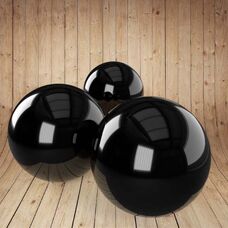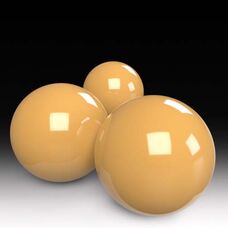Color Glazes are particularly suitable for the art ceramics
AIR FORCE blue - Color Glaze Gloss Semi-transparent BASF
Quantity: 40 g. (1.41 oz.) If you need larger quantity, please askFiring temperature: 980-1080°C&nbs..
0.79€
AIR SUPERIORITY BLUE - Color Glaze Gloss Semi-transparent BASF
Many people want to know what is glaze. Glazing is a technique that requires:Liquid Glaze is perfect for brush on. ..
0.79€
ASHES OF ROSES pink - Color Glaze Gloss Semi-transparent BASF
Many people want to know what is glaze. Glazing is a technique that requires:Liquid Glaze is perfect for brush on. ..
0.79€
BLACK - Color Glaze Gloss Semi-transparent DEGUSSA
Quantity: 40 g. (1.41 oz.) If you need larger quantity, please ask Firing temperature: 980-1080..
0.79€
CADMIUM orange - Color Glaze Gloss Semi-transparent BASF
Orange ceramics can bring warmth, vibrancy, and a pop of color to various pottery and ceramic pieces. Here are a few exa..
0.99€ 1.19€
CARAMEL brown - Color Glaze Gloss Semi-transparent BASF
Many people want to know what is glaze. Glazing is a technique that requires:Liquid Glaze is perfect for brush on. ..
0.79€ 0.99€
CARMINE-PINK - Color Glaze Gloss Semi-transparent BASF
Many people want to know what is glaze. Glazing is a technique that requires:Liquid Glaze is perfect for brush on. ..
0.99€
CELESTE blue - Color Glaze Gloss Semi-transparent BASF
Many people want to know what is glaze. Glazing is a technique that requires:Liquid Glaze is perfect for brush on. ..
0.39€ 0.79€
COBALT Blue - Color Glaze Gloss Semi-transparent BASF
Many people want to know what is glaze. Glazing is a technique that requires:Liquid Glaze is perfect for brush on. ..
0.79€ 0.99€
COQUELICOT RED - Color Red Pottery Glaze Gloss Semi-transparent BASF
Many people want to know what is glaze. Glazing is a technique that requires:Liquid Glaze is perfect for brush on. ..
0.79€
DARK BEIGE - Color Glaze Gloss Semi-transparent BASF
Many people want to know what is glaze. Glazing with Dark Beige Color is a technique that requires:Liquid Glaze is ..
0.79€
DARK BISTRE (very dark brown till black) - Color Glaze Gloss Semi-transparent BASF
Quantity: 40 g. (1.41 oz.) If you need larger quantity, please ask Firing temperature: 980-1080..
0.79€
DARK LIVER brown - Color Glaze Gloss Semi-transparent BASF
Quantity: 40 g. (1.41 oz.) If you need larger quantity, please ask Firing temperature: 980-1080..
0.79€
DIM GREY - Color Glaze Gloss Semi-transparent BASF
Quantity: 40 g. (1.41 oz.) If you need larger quantity, please ask Firing temperature: 980-1080..
0.75€ 0.99€
GINGER Brown - Color Glaze Gloss Semi-transparent BASF
Quantity: 40 g. (1.41 oz.) If you need larger quantity, please ask Firing temperature: 980-1080..
0.79€
GRASS green - Color Glaze Gloss Semi-transparent BASF
Many people want to know what is glaze. Glazing is a technique that requires:Liquid Glaze is perfect for brush on. ..
0.79€
IMPERIAL BLUE Color Glaze Gloss Semi-transparent BASF
Imperial Blue Brush-On Color earthenware glaze is available prepared to use straight from the bottle, smoothly stir well..
0.99€
LA SALLE green - Color Glaze Gloss Semi-transparent BASF
Many people want to know what is glaze. Glazing is a technique that requires:Liquid Glaze is perfect for brush on. ..
0.79€ 0.99€
LIGHT BEIGE - Color Glaze Gloss Semi-transparent BASF
Quantity: 40 g. (1.41 oz.) If you need larger quantity, please ask Firing temperature: 980-1080..
0.79€
LIGHT SKY blue - Color Glaze Gloss Semi-transparent BASF
Quantity: 40 g. (1.41 oz.) If you need larger quantity, please ask Firing temperature: 980-1080..
0.79€
MAHOGANY brown - Color Glaze Gloss Semi-transparent Mahoganie Brown
Quantity: 40 g. (1.41 oz.) If you need larger quantity, please ask Firing temperature: 980-1080..
0.79€
MAUVE PURPLE - Color Glaze Gloss Semi-transparent Purple Glaze Pottery
How to use the color glazes?Liquid Glaze is perfect for brush on. It should be coated 2-3 times with a soft brush a..
0.79€
MEDALLION - Color Glaze Gloss Semi-transparent BASF
Quantity: 40 g. (1.41 oz.) If you need larger quantity, please ask Firing temperature: 980-1080..
0.79€ 0.99€
MINT GREEN - Color Glaze Gloss Semi-transparent BASF
Many people want to know what is glaze. Glazing is a technique that requires:Liquid Glaze is perfect for brush on. ..
0.79€

























